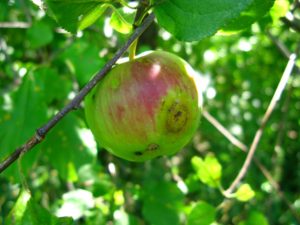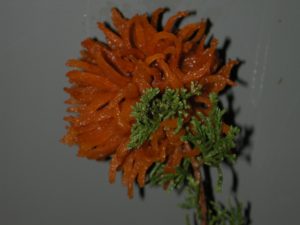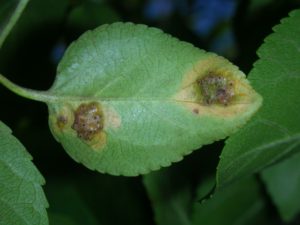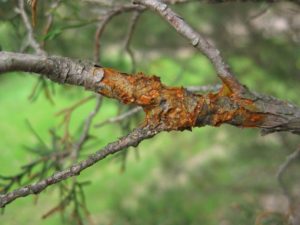Although the season for primary scab infection is winding down, this cool, wet weather is making for an excellent infection period for juniper rusts (Gymnosporangium spp). John Obermeyer and I created this time-lapse video to help explain the complicated lifecycle of this fascinating pathogen: http://tinyurl.com/j3s3t92
The juniper rusts standout due to the conspicuous nature of the disease, and the fact the fungus completes its life cycle on two plant hosts—the Juniper (cedar) (Fig. 1), which none of us cares about, and the apple (Fig. 2), and to a less important degree here, the pear, quince, hawthorn, serviceberry and crabapple are other hosts.
All potential host plants are commonly planted or are native throughout the Midwest, and all serve as hosts to more than 70 juniper rust diseases. The three most common, and damaging to the apple orchard are:
Cedar-apple rust, caused by the fungus Gymnosporangium juniperi-virginianae, requires two host to complete its life cycle: the fungus must infect apple or crabapple in the spring, and an alternate host, Eastern red cedar (Juniperus virginiana) or Rocky Mountain juniper (J. scopulorum) in the late summer, before infecting apple (Fig. 3).
Cedar-hawthorn rust, caused by Gymnosporangium globosum, alternates between junipers and hawthorn, crabapple, and apple in addition to several other rosaceous hosts (Fig. 1). This rust creates the big, conspicuous galls that everyone associates with ‘cedar-apple’ rust.
Cedar-quince rust, caused by Gymnosporangium clavipes, that infects junipers and a wide range of rosaceous hosts, namely hawthorn, but also quince, pear, and serviceberry (Fig.4).
Symptoms and signs of the disease occur in the spring; orange gelatinous horns develop from gray to brown colored fungal galls on the branches of infected junipers. These horns produce wind blown spores that infect apple and/or pear, hawthorn, serviceberry and/or crabapple trees. Symptoms on apple initially appear on the upper leaf surface as small yellow spots that later enlarge and turn orange. As the fungus continues to grow, yellow-brown lesions develop on the underside of the leaf and form small, whisker-like structures containing rust-colored spores. These spores are blown to susceptible junipers, and continue the infection cycle by producing galls. The following spring, these galls produce orange gelatinous horns that release spores and continue the infection cycle. Dead galls on cedar and juniper may remain attached for a year or more.
In the orchard, where systemic or translaminar fungicides are used regularly to manage scab, rust is rarely a problem. Growers who have been dealing with fungicide resistance with DMI and QoI fungicides and no longer use these classes of fungicides may find it challenging to control this disease with just mancozeb, which provides good control when used preventatively, but fair to poor control when used after infection events. Remember that neither captan nor Topsin M controls rust. Even growers with a history of DMI resistant scab may consider still using Rally (or other DMI fungicides like Topguard, Indar, Inspire) simply to control rust. As always, remember post-infection applications (aka ‘curative’) will not provide the same level of control as preventative applications of fungicide.
Removal of nearby junipers (cedars) may help, but remember that spores may be blown from neighboring trees (from a two mile radius) allowing the disease to continue.
Lastly, there are always new rusts being found, or worse still, being introduced in Indiana. One such rust, Japanese apple rust, Gymnosporangium yamadae, had only been found in Asia (China, Japan and Korea) where it can be a serious pathogen of cultivated apples wherever Juniperus spp. occur in close proximity. This fungus was recently reported from the United States (DE, PA) in its aecial state on the ornamental crabapple, Malus toringo(Yun et al. 2009). This rust looks very similar to cedar-hawthorn rust. For more information see: http://nt.ars-grin.gov/taxadescriptions/factsheets/index.cfm?thisapp=Gymnosporangiumyamadae
Hopefully, you won’t see any rust on your apples, but if you do see anything unusual, please contact me or the Purdue Plant and Pest diagnostic lab.
Yun, H.Y. Systematic Mycology and Microbiology Laboratory, ARS, USDA. . Invasive Fungi. Japanese apple rust. Retrieved May 9, 2016, from /sbmlweb/fungi/index.cfm



